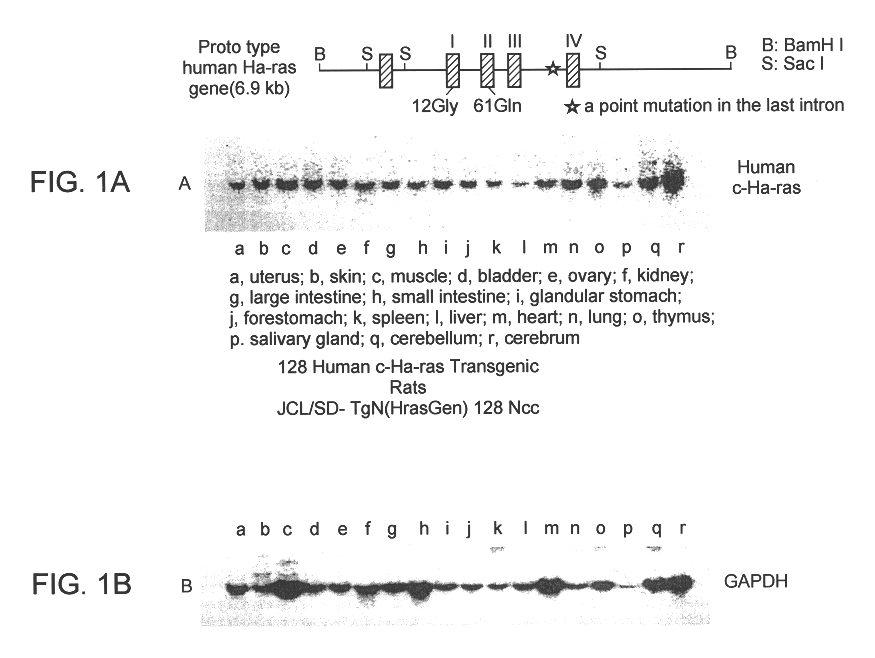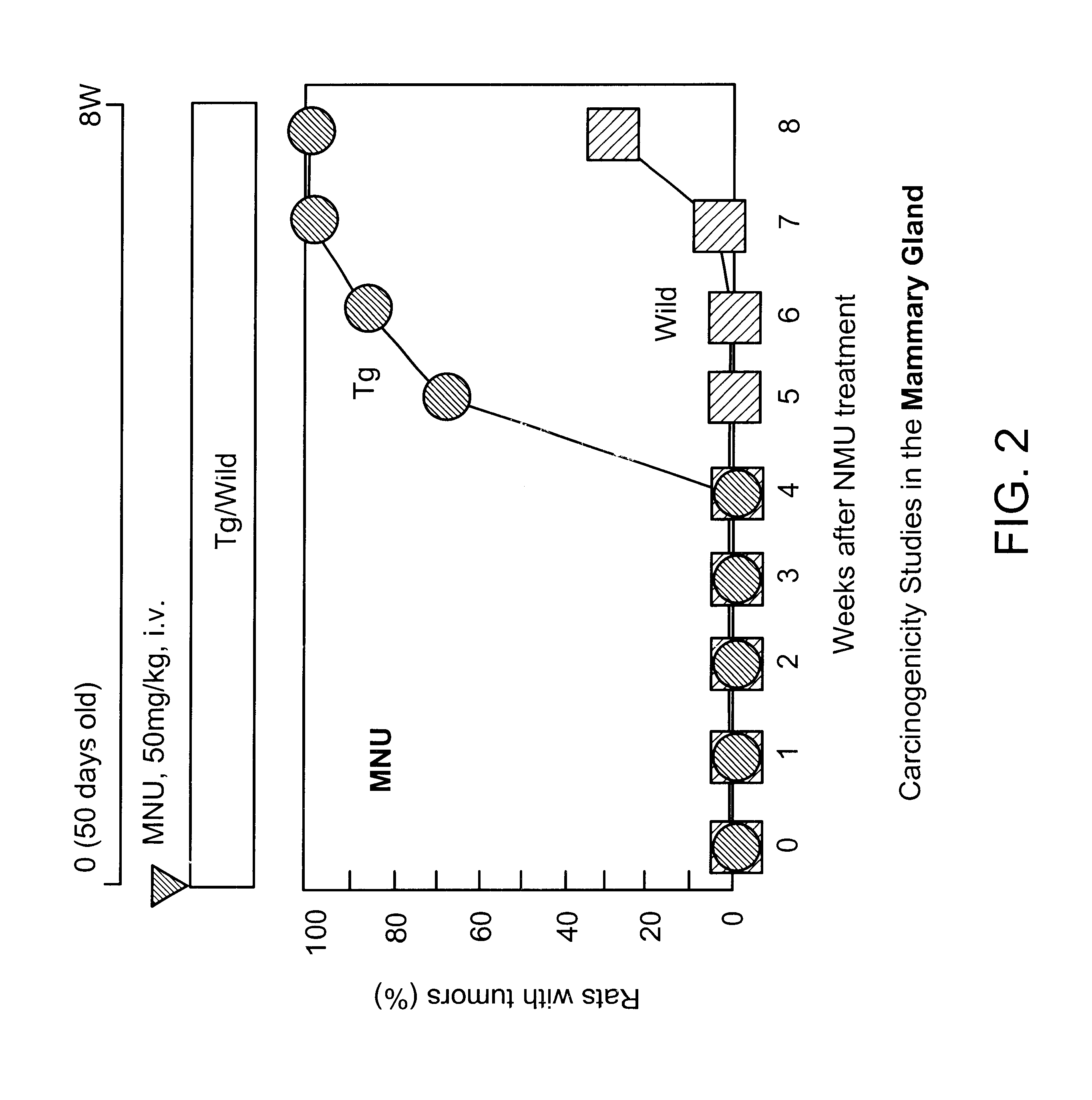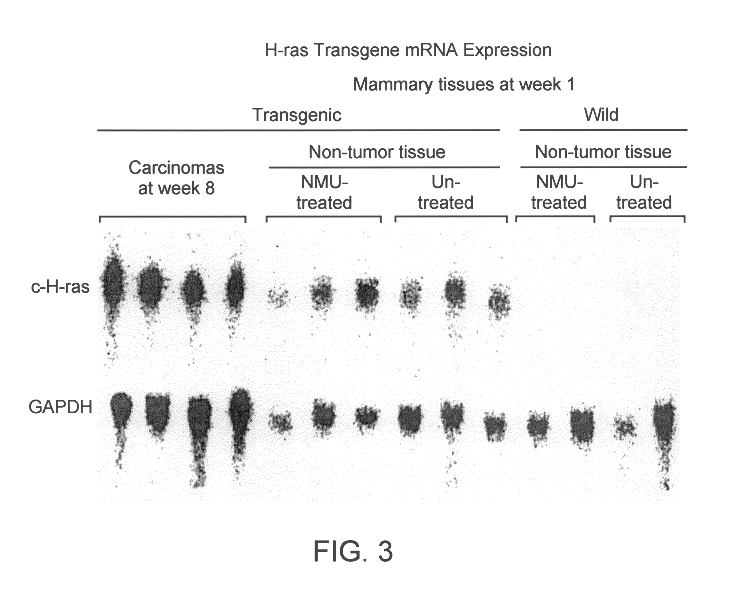Transgenic rat with human normal type c-Ha-ras gene
a human gene and gene technology, applied in the field of human charas protooncogenes transgenic rat, can solve the problems of tumor induction in many other important organs such as gastrointestinal tracts, urogenital organs and endocrine organs, and the limitation of organs in which tumors develop to the lung, skin, and forestomach
- Summary
- Abstract
- Description
- Claims
- Application Information
AI Technical Summary
Problems solved by technology
Method used
Image
Examples
example 1
By microinjection, human c-Ha-ras proto-oncogene was transgened, together with its promoter / enhancer regions into a fertilized eggs from SD rats, then transferred into the sallopian tube of a pseudo-pregnant foster mother to raise the fetuses and deliver pups.
Two strains of gene could be transgened, Hras102 and Hras128 rats carrying one copy and three copies respectively. The transgene was transmitted to their progenies in a stable manner. The transgene expression was confirmed in almost all organs, as shown by Nothern blotting in FIG. 1.
example 2
MNU, at a dose of 50 mg / kg, was intravenously injected into Hras128 and wild type rats, at 50 days old, to perform histopathological examination of the incidence of mammary tumor and to screen the presence or absence of any point mutation of the transgene and endogenous c-Ha-ras gene.
Mammary tumor became palpable in the Hras128 strain rats, 5 weeks after MNU administration, and then multiple adenocarcinoma developed in all (100%) of the mammary glands of all the transgenic rats at week 8, but that in the wild type rats only 29.2% even at week 8 (see Table 1 and FIG. 2). In 102-strain rats, multiple adenocarcinoma was observed 16 weeks after MNU administration.
The results are shown in Table 4 and FIG. 2.
Herein, "Tg" shown as closed circle in FIG. 2 expresses the rats with the human c-Ha-ras proto-oncogene in the present invention; "Wild" shown with closed square expresses wild type rats (non Tg rats).
TABLE 4 Tumor-Inducing by MNU in Tg Rats week No. after of tumor- MNU MNU No. of bea...
example 3
Well established mammary carcinogens, such as 7,14-dimethylbenz[a]anthracene (DMBA) and 2-amino-1-methyl-6-phenylimidazo[4,5-]pyridlne (PhIP) were given to the Hras128 rats in the same manner as in previous reports.
The results are shown in FIG. 6 (DMBA) and FIG. 7 (PhIP). The Hras128 rats exerted high sensitivity to the all those carcinogens.
"Tg" shown with closed circle in FIGS. 6 and 7 expresses the Hras128 rats of the present invention; and "Wild" shown with closed square expresses the wild type rats (non Tg rats).
Table 5 shows the incidence and the number and the size of mammary carcinomas induced by DMBA. The number of tumor indicates number of lesions per rat and the sizes of the tumors indicates their diameter (mm). Table 6 shows the frequency of mutations in the codon 12 or 61 by RFLP analysis.
The Hras128 rat was very sensitive to DMBA, and mutation was detected in the codons 12 (6 / 20) and 61 (7 / 20) of the transgene by RFLP analysis.
TABLE 5 Incidence and Multiplicity of Carc...
PUM
| Property | Measurement | Unit |
|---|---|---|
| Mass | aaaaa | aaaaa |
| Mass | aaaaa | aaaaa |
| Mass | aaaaa | aaaaa |
Abstract
Description
Claims
Application Information
 Login to View More
Login to View More - R&D
- Intellectual Property
- Life Sciences
- Materials
- Tech Scout
- Unparalleled Data Quality
- Higher Quality Content
- 60% Fewer Hallucinations
Browse by: Latest US Patents, China's latest patents, Technical Efficacy Thesaurus, Application Domain, Technology Topic, Popular Technical Reports.
© 2025 PatSnap. All rights reserved.Legal|Privacy policy|Modern Slavery Act Transparency Statement|Sitemap|About US| Contact US: help@patsnap.com



